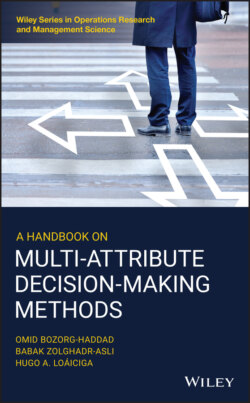Читать книгу A Handbook on Multi-Attribute Decision-Making Methods - Omid Bozorg-Haddad - Страница 9
1.2.1 Preference Evaluation Mechanism
ОглавлениеEvery MADM method requires a preference evaluation mechanism for the purpose of reflecting the stockholders’ preferences in the decision‐making process. These mechanisms act as a measure that enables decision‐makers evaluating alternatives according to their attributes. The mechanism can be defined either explicitly (where the preference values are computable through a set of predefined boundaries or mathematical functions), or they can be defined implicitly so that the decision‐makers’ experiences, expertise, perception, and instincts are reflected in the alternatives’ preference evaluation.
A classification based on the notion of preference evaluation mechanism divides MADM methods into multiattribute utility theory (MAUT) and outranking methods (Belton and Stewart 2002; Mendoza and Martins 2006). On the basis of Bernoulli’s utility theory MAUT methods obtain the decision‐makers’ preferences, which can usually be represented as a hierarchical structure by using an appropriate utility function. By evaluating the utility function the alternative with the highest utility value can be identified as the solution to the MADM problem at hand. In spite of their reliance of solid axiomatic background of MAUT methods, they are criticized by their unrealistic assumption of preferential independencies (Tzeng and Huang 2011). Preferential independence describes situations in which the preferred outcome of one criterion over another is not influenced by the remaining criteria. However, it so happens that the criteria are usually interactive in real‐world MADM problems. Alternatively, instead of building complex utility functions, outranking methods compare the preference relations among alternatives to determine on the best alternatives. The outranking methods were introduced to overcome the empirical difficulties experienced with the utility function in handling practical problems. Yet they lack axiomatic foundation, such as is the case with classical aggregate problems and structural problems (Tzeng and Huang 2011).
The previous classification categorizes classical MADM methods, yet it may face difficulties categorizing some of the modern MADM methods whose features do not fit either one of the previously cited categories. Belton and Stewart (2002) proposed a more sophisticated classification system for MADM methods that addresses the latter classification difficulties. The alternate classification categorizes the MADM methods within three classes, namely, value measurement, goal aspirations or reference level, and outranking methods. This classification is a reviewed next.
Value‐measurement MADM methods implement numerical scales to represent the degree to which a feasible alternative may be preferable to another. The scores obtained for each alternative are developed initially for each individual evaluation criterion and are then synthesized to rate the overall performance of the alternatives. The scores assigned to each of the feasible alternatives reflect a preference order. These preferences must be consistent with a set of axioms, which are as follows (Belton and Stewart 2002; Mendoza and Martins 2006):
1 (I) Constant discipline and roles must be imposed by the decision‐maker in the construction procedure of preference measurement scales;
2 (II) Provide a framework through which the decision‐makers are able to systematically analyze the obtained preference values and gain a deeper understanding of the process that led to the final results; and
3 (III) Promoting explicit statements, rather than implicit judgments regarding the trade‐offs between evaluation criteria.
Desirable or satisfactory levels of achievement must be defined by the decision‐makers for each evaluation criterion. Through these reference level methods, those alternatives that are closest to achieving the goals or aspirations are identified. These types of MADM methods are recommended for those cases in which decision‐makers may not be able to express trade‐offs or identify importance weights of the evaluation criteria. Nevertheless, the most desirable outcome can be portrayed through arbitrary aspirations or goals for each criterion. As far as these branches of MADM is concerned, an alternative that represents the most similarities with the arbitrary defined ideal solution can best reflect the stakeholders’ interests in the process of decision‐making. Through the framework represented by this branch of MADM methods, the feasible alternatives, which are available courses of actions, are systematically eliminated until achieving a solution that best fits the stakeholders’ ideal outcome for the MADM problem at hand (Belton and Stewart 2002; Mendoza and Martins 2006).
Lastly, outranking MADM methods evaluate alternatives’ relative performances against one another using a comparison‐oriented framework. Outranking MADM methods, the first evaluate feasible alternatives by the decision‐makers in terms of evaluation criteria to establish their merits. This is followed by an aggregation stage whereby the gathered information is used as evidence to obtain an alternative that outrank others and emerges as the optimal solution. The aggregation stage establishes the relations between the alternatives in terms of preference, indifference, and incomparability. Consequently, a complete ranking of alternatives is produced.
